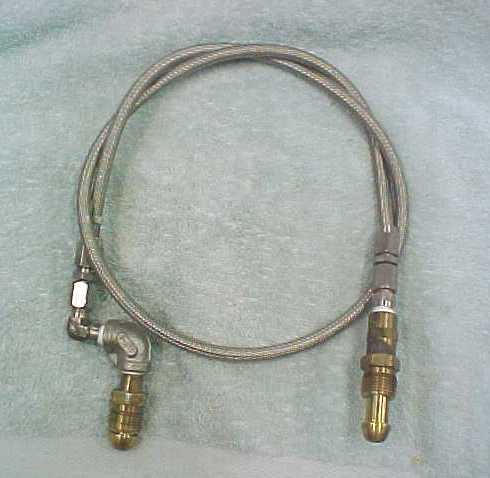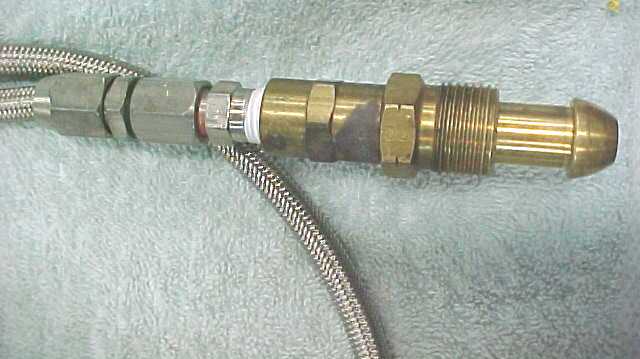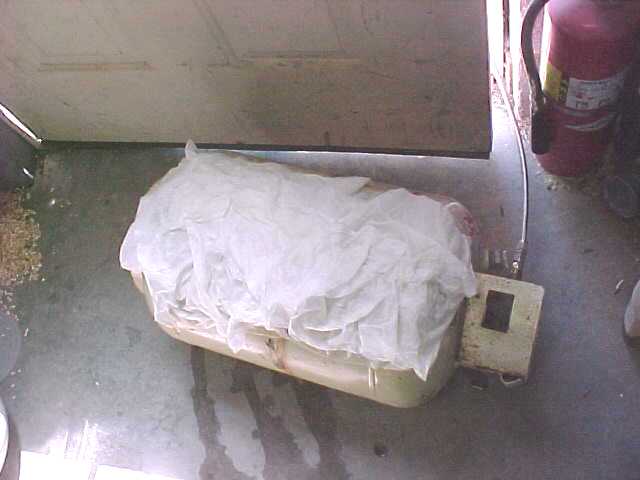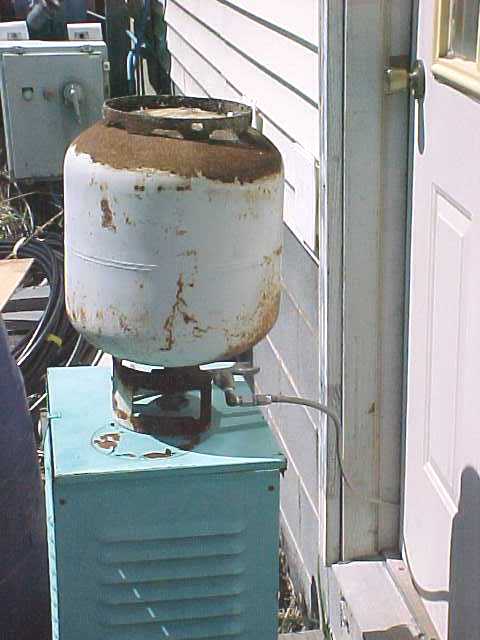IF YOU REACHED THIS PAGE VIA A SEARCH ENGINE THIS WILL TAKE YOU TO OUR HOME PAGE
Filling
Propane Tanks
or
How
to Transfer Propane From Tank-To-Tank
Right off the bat, let me say that this procedure may be both illegal and/or dangerous. Check your local laws and your life insurance policy.
Propane stored in tanks is usually in both liquid and gas (vapor) phases. As propane gas is withdrawn, the liquid "boils" and makes some more gas. Of course, the liquid is at the bottom, as any good liquid should be, and the gas is at the top, like a well-behaved gas. If we confine ourselves to talking about 20-pound "gas-grill" type tanks, and common 100-pound tanks, then turning the tank so the valve is at the top will allow gas to escape when the valve is opened. But, if we invert the tank so the valve is at the bottom, then liquid propane will come out.
Now, the pressure in the tank, if there is even a drop of liquid, will vary with the tank temperature, as in the following table:
|
Vapor
pressure of liquid propane at various temperatures |
|
|
Temperature
of Liquid (F) |
Approximate
Pressure of Gas (psi) |
|
-40 |
1.3 |
|
-30 |
5.5 |
|
-20 |
10.7 |
|
-10 |
16.7 |
|
0 |
23.5 |
|
10 |
31.3 |
|
20 |
40.8 |
|
30 |
51.6 |
|
40 |
63.3 |
|
50 |
77.1 |
|
60 |
92.5 |
|
70 |
109.3 |
|
80 |
128.1 |
|
90 |
149.3 |
|
100 |
172.3 |
|
110 |
197.3 |
As the tank temperature rises, liquid "boils" off, making gas, and the pressure increases. If we have a tank at 70 degrees, the pressure will be 109 PSI, and raise the temperature to 80 degrees, the liquid will "boil" and the pressure will become 128 PSI.
If two tanks are connected, they become one tank, and the pressure WILL be equal throughout the tank. If one end of the tank is hotter than the other end, any liquid at the hotter end will "boil" and the gas at the cold end will condense and become liquid.

To connect two tanks together, a flexible hose capable of withstanding at least 250 or 300 PSI is fitted with two POL fittings. These can be salvaged from propane regulators or purchased for about $8. They normally have 1/4-inch pipe threads. The little jog at the one end is not needed, I jut had a 90-degree fitting and had to use it.

This is what each end needs to look like.

Here is a 30-pound tank, covered with wet towels, forming the "cold end" of our "big" tank. I am filling this tank.

And here is a 20-pound tank, forming the "hot end" of our big tank. The cold end is in the shade, covered with wet towels, while the hot end is setting in direct sun light. The connecting portion of the tank (hose) can be seen snaking through the door. It is not necessary to invert the "hot" end tank, but if inverted, you will be transferring liquid, and that saves a lot of time. A liquid transfer, as above, may take an hour, while gas transfer may take 24 hours, with a greater temperature difference makes things go faster.
NEVER HEAT THE TANK WITH A FLAME!!!
Now, here is the safety talk. If you live in the US, you may know that the "LAW" requires all (MOST) tanks less than 40 some odd pounds to be fitted with an OPD, or Overfill Protection Device, AND makes filling of those tanks not so equipped illegal. This is because IF THERE IS NOT A REASONABLE "GAS SPACE", that is, if the tank is filled completely with liquid, it will EXPLODE if the temperature is raised only a few degrees. The reason the OPD's were mandated is because of weakly educated convenience store employees who could/would fill a tank completely full of liquid propane. And this also applies to YOU. Make sure that any tank you fill has a gas space at the top. You can insure this by never filling a small tank from a big tank, or by weighing the tank to insure that it is not filled too beyond it design capacity.
When removing the hose, loosen the POL nut slowly, as some liquid may be trapped and could freeze the skin if you come in contact with it.